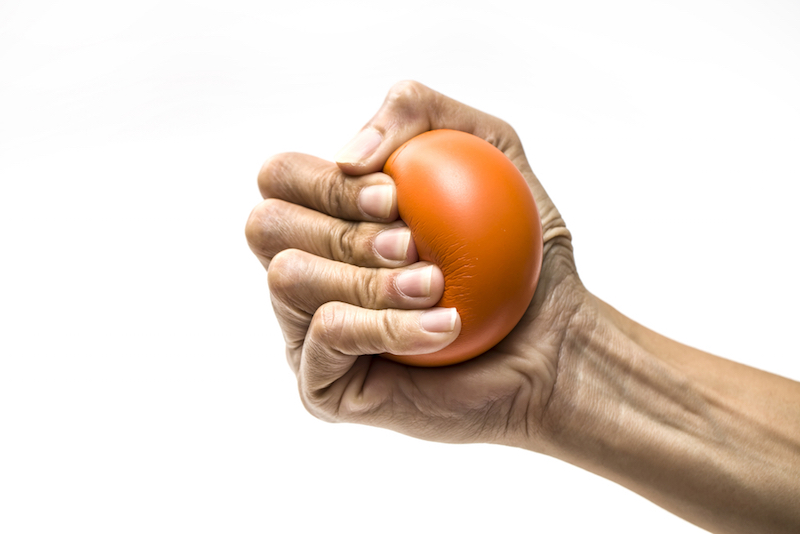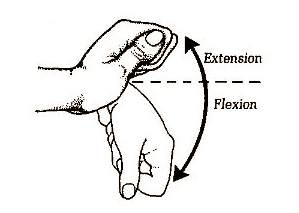
Ice-ma-gedon 2019 lead to an increase in the amount of slip and fall injuries seen at our clinic.
One of the more common slip and fall injuries is a broken wrist. Some people will call it a wrist “fracture”. When talking about bones, “broken” and “fractured” mean the same thing.
A “broken wrist” can mean a lot of things, depending on who you ask. This blog aims to be a general overview of the wrist, how to know if you broke it, and the best things you can do if suffered a broken wrist. We will also cover some great rehabilitation tips and tricks!
Wrist Anatomy
There’s a lot more to wrists than most people realize. The “wrist” is made up of 8 different smaller bones (called carpal bones). We also have 2 forearm bones (called your radius and ulna) that connect to various parts of these 8 wrist bones. If you have a broken wrist, it’s most likely you actually fractured a forearm bone (usually your radius). If the break is close to the carpal bones, it will simply get called a “wrist fracture” or “broken wrist”, as that makes sense to most people.
Here’s a picture of our wrist bones:

While this picture only shows the bones, it is important to remember that our wrists also have muscles/tendons, nerves, arteries, and veins running through them, as well as A LOT of ligaments (don’t believe me? Google: “ligaments of the wrist”. There are 21 ligaments in your wrist alone!).
This blog is focusing on wrist fractures (broken bones), so we will stop the anatomy lesson here. However, don’t forget all the other things around the wrist, as they can play a role in injury severity, recovery, and rehabilitation.
How Do I Know If I Have A Broken Wrist? Sprain vs Strain vs Fracture
A broken wrist or “wrist fracture” refers to a bone injury, but how do we know if it’s a bone injury or something different? Let’s dive in.
“Broken” wrist, or wrist “fracture: the bone has been damaged (i.e. cracked, chipped, or broken into 2 or more pieces)
Wrist “sprain”: 1 or more wrist ligaments have been injured
- Ligaments are passive (ie we can’t control them) structures that hold 2 or more bones together
Wrist “strain”: 1 or more wrist muscles have been injured
- Muscles are active (ie we can control them) structures that move our bones
- Muscles turn into tendons, and tendons attach to bone
- Therefore, we can also injure wrist tendons, often called wrist tendonitis
So, how do you know if you broke your wrist?
Great question.
First, a wrist fracture almost always has an associated “event” or “trauma” – like a fall onto your hand/wrist, or car accident. Whereas muscle or tendon injuries usually come from overloading the wrist (i.e. after a lot of lifting, or gripping).
That said, wrist sprains (ligament injuries) also usually have an associated “event”, most commonly when a sudden or gradual awkward movement/twisting of the wrist occurs. Differentiating a “broken wrist” from a “sprained wrist” can be challenging at times.
Here’s some more clues:

If you’re unsure, it’s better to be safe than sorry and seek professional guidance, and to get an x-ray.
Common Types of Wrist Fractures
As mentioned, having a “broken wrist” can mean a lot of things, and more often than not, it’s actually a forearm bone that gets broken (close to the wrist joint). Here’s a brief outline of the more common types of wrist fractures.
Distal Radius Fracture
- Distal means “away from the centre of your body”, so in this case, closer to your hand. Your radius is the forearm bone that connects to your carpal (wrist) bones, on the thumb side of you hand. Therefore, a “distal radius fracture” is a broken forearm bone close to your wrist crease, on the thumb side.
Colles’ Fracture
- A “Colles’” fracture is a type of distal radius fracture.
- Usually happens by falling onto an outstretched hand (FOOSH), with your hand extended backwards.
- This fracture causes the broken piece of the radius bone to move higher up on the back of the wrist. The “dinner fork deformity” (see below).

Smith’s Fracture
- A “Smith’s” fracture is a less common type of distal radius fracture
- Usually happens by either falling onto your wrist while it’s flexed forwards, or a direct blow to the back of the wrist.
- Sometimes called a “reverse Colles’ fracture”, and the fracture causes the broken piece of bone to move forward in the wrist.
- Can be more serious because the front of the wrist is where the blood vessels and nerves are situated (and these can be damaged, leading to complications)
Scaphoid Fracture
The scaphoid bone is a carpal bone (look back at the picture above).
Like a Colles’ fracture, it usually happens by falling onto an outstretched hand (FOOSH), with your hand extended backwards.
This fracture can have a complication called “avascular necrosis” in which the bone heals poorly due to poor blood supply.
What To Expect and The Best Things To Do
So you think you’ve broken your wrist? Now what?
The best first option is to confirm/rule out the fracture (and type of fracture) by getting an x-ray. If you have a broken wrist, here’s a rough guideline of what will happen:
1. The doctors and specialists will determine if the broken wrist requires surgery, or if it only requires a cast (we’ll get to that). If you need surgery, the surgeon will do the surgery as soon as possible, then place you in a cast. If they decide not to do surgery, your bones with be “set” back in their proper place, then place you in a cast.
2. The cast will stay on for 2-12 weeks, a HUGE variance that depends on:
- Age – children typically require less time in a cast
- Complications or risk of complications may mean you’re in the cast longer
- Whether or not you had surgery
- Whether or not the bone is healing back together properly (when it’s not healing well it’s usually called malunion or non-union) – if the bone is slow to heal back together, then the cast will be on for longer.
- Note: sometimes you will go in one cast for 1-2 weeks (when the swelling is at its highest), then you’ll get a new, longer-lasting cast once some swelling has subsided.
3. When your bone heals, the surgeon/specialist will take off the cast, and you will start physiotherapy Kitchener. Depending on your goals, what you need/want to be able to do with your hand, what you do for work, what sports you play, whether or not there were complications with your fracture/surgery, physiotherapy will usually last 1-6 months after your cast comes off.
4. The specialist and your physiotherapist will determine when it is safe for you to return to work, sports, activities, etc (which of course, is highly individualized)
Broken Wrist Exercises
There are lots of options for exercises after your cast comes off. The best thing to do is to have a physiotherapist assess your individual situation so that the most individualized plan of care can be created.
For the sake of this blog, I will outline 2 beginner exercises, 2 intermediate exercises, and 2 advanced exercises. These are in no way inclusive, and are certainly not for everyone. They are intended to be used for information purposes only, and not as strict medical advice.
Beginner Broken Wrist Exercises
1. Ball squeezes
- Get a squishy stress ball and hold it in your hand
- Squeeze it (without pain) and hold for 5-10 seconds. Repeat 10 times. Do 3-5 times per day.
2. Wrist flexion and extension range of motion
- Support your forearm, and bend your wrist up and down as far as you can (pain-free). You can use your other hand to help it go further. Repeat 10 times in each direction. Rest. Do 10 more in each direction. Repeat 3 times per day.
Intermediate Broken Wrist Exercises
1. Wrist flexion and extension with dumbbell
- As above, but hold a dumbbell in your hand. Repeat 2 sets of 10 reps, 2 times per day
2. Wrist pronation and supination with hammer
- Hold a hammer in your hand with your elbow bent to 90 degrees. Rotate the hammer in each direction.
- Start with 10 times each way. Do 2 sets. Repeat 2 times a day.
- The closer your hand is to the head of the hammer, the easier it will be.
Advances Broken Wrist Exercises
1. Push-ups
- Start from your hands and knees if you have to, and try to progress to full push ups (from your toes). Progress to 2 sets of 10 reps. Complete 1-2x/day.
2. Chin-ups
- Stand on a step in front of a pull up bar. Grab onto the bars so your palms are facing you. Then pull yourself up, squeezing your shoulder blades together, until your chin is above the bar. Slowly lower yourself back down and repeat.
- Try to progress to 2 sets of 10 reps. Complete 1-2x/day

By reading this blog, you now understand the anatomy of the wrist, how to know if you’ve broken it, and what you should do about it if you did! At Strive Physiotherapy & Performance, we are committed to providing an in-depth, one-on-one assessment to ensure we can work together to find the best plan of action for each individual client.
Broke your wrist? Call us at 519-895-2020, or use our online booking tool on www.strivept.ca to book an appointment with one of our knowledgeable physiotherapists, and they will be sure to help you understand your injury.
Take care,
Tyler Allen
Physiotherapist at Strive Physiotherapy & Performance
Keywords:
#Wrist #Colles #fracture #CollesFracture #WristBones #Scaphoid #ScaphoidFracture #Broken #BrokenWrist #Distal #radius #DistalRadiusfracture
#Sprain #Injuries #symptoms #bones #MSK




